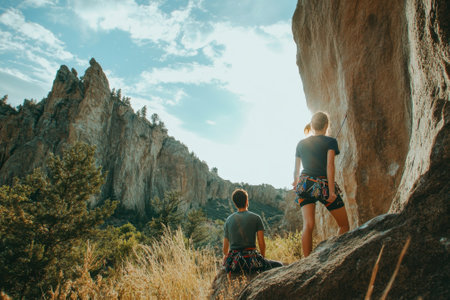Introduction to Rocky Mountain Hiking
The Rocky Mountains are one of America’s most iconic outdoor playgrounds, stretching from northern New Mexico all the way up through Colorado, Wyoming, Montana, and into Canada. For generations, hikers have been drawn to these rugged peaks, scenic valleys, and wild alpine meadows. The hiking culture here is rich and inviting—whether you’re a local hitting the trails every weekend or a visitor seeking your first taste of high-elevation adventure, there’s something for everyone.
What Makes Rocky Mountain Terrain Unique?
Hiking in the Rockies isn’t like strolling through your neighborhood park. The landscape is dramatic and ever-changing. You’ll encounter steep inclines, loose rocks, scree fields, and sometimes even snow patches—even during summer months! High altitude means thinner air and cooler temperatures, while unpredictable weather can bring sunshine one minute and thunderstorms the next. Here’s a quick look at what makes this region so distinct:
| Terrain Feature | Description | Impact on Footwear |
|---|---|---|
| Rocky Trails | Loose stones and sharp rocks common on paths | Requires sturdy soles and toe protection |
| High Elevation | Thinner air, cooler temps, intense sun exposure | Breathable but insulating boots recommended |
| Scree Slopes & Boulder Fields | Unstable gravel slopes and large rock areas | Ankle support and solid grip needed |
| Muddy Sections & Water Crossings | Snowmelt creates muddy patches and streams | Waterproofing is a big plus |
| Alpine Meadows & Forests | Varied terrain with roots and uneven ground | Cushioning for comfort on longer hikes |
The Role of Footwear in Your Rocky Mountain Adventure
Your choice of hiking boots matters more here than almost anywhere else. With so many challenges underfoot—slippery rocks, sudden temperature changes, unexpected rain or snow—a reliable pair of boots can make or break your adventure. Hikers in the Rockies often swap stories about gear around campfires or trailheads because finding the right fit for this environment is part of the experience.
2. What to Look for in a Hiking Boot
If you’re planning to hike the rugged and diverse trails of the Rocky Mountains, choosing the right pair of hiking boots is essential. Not only do these boots need to handle rocky terrain and sudden weather changes, but they also have to keep you comfortable during long days outdoors. Here are some key features you should look for when picking out hiking boots for your next Rocky Mountain adventure:
Key Features to Consider
| Feature | Why It Matters for the Rockies |
|---|---|
| Traction | The Rockies are known for steep inclines, loose gravel, and sometimes slick surfaces. Look for boots with deep, multi-directional lugs for reliable grip. |
| Ankle Support | Uneven ground and rocky paths can increase your risk of twisting an ankle. High-cut or mid-cut boots provide better support and help prevent injuries. |
| Waterproofing | Weather in the Rockies can change quickly, and snowfields or stream crossings are common. Waterproof membranes like Gore-Tex keep your feet dry without sacrificing breathability. |
| Durability | Rocky trails can be tough on gear. Boots made from full-grain leather or reinforced synthetic materials will last longer against scrapes and rough use. |
Additional Tips for Rocky Mountain Hikers
- Fit is Everything: Make sure there’s enough room in the toe box for downhill hikes, but no heel slip that could cause blisters.
- Sole Stiffness: A stiffer sole helps protect your feet from sharp rocks and provides better stability on uneven ground.
- Lacing System: Secure laces that stay tight can help keep your foot stable inside the boot during steep climbs or descents.
- Weight: Lightweight boots are great for speed, but if you carry heavy packs or tackle technical trails, opt for sturdier models.
Quick Checklist Before You Buy
- Test boots with the socks you’ll wear on the trail
- Walk up and down an incline if possible (many outdoor stores offer this)
- Bend the boot – it should flex at the ball of your foot, not the arch
- Check return policies; sometimes it takes a few hikes to know if they’re perfect!
![]()
3. Top Hiking Boot Picks for Rocky Mountain Terrain
Choosing the right hiking boots for the Rocky Mountains is all about blending comfort, durability, and traction. With everything from wildflower-filled meadows to steep rocky passes, you’ll want footwear that can handle varied terrain, sudden weather changes, and long days on the trail. Here are some top picks recommended by Colorado locals, outdoor enthusiasts, and gear experts. Each boot is chosen for its performance across the region’s diverse landscapes.
Boot Recommendations at a Glance
| Brand & Model | Best For | Main Features | Why Locals Love It |
|---|---|---|---|
| Salomon X Ultra 4 Mid GTX | Day Hikes & Technical Trails | Lightweight, Gore-Tex waterproofing, aggressive grip | Perfect mix of agility and protection; excels on rocky switchbacks and sudden storms. |
| Keen Targhee III Waterproof Mid | Muddy or Wet Conditions | Wide toe box, durable leather, breathable membrane | Super comfy fit with extra room; trusted for spring mud and creek crossings. |
| La Sportiva Nucleo High II GTX | Backpacking & Steep Climbs | Vibram sole, waterproof yet breathable knit paneling | Loved for ankle support and grip on loose scree and alpine slopes. |
| Merrell Moab 3 Mid Waterproof | All-Around Versatility | Cushioned insole, Vibram outsole, affordable price point | A classic favorite for comfort right out of the box; handles everything from foothills to summit pushes. |
| Lowa Renegade GTX Mid | Long-Distance Treks & Backpacking | Nubuck leather, stable midsole, GORE-TEX lining | Praised for lasting comfort on multi-day trips and rugged terrain. |
What Makes These Boots Stand Out?
Tough Uppers & Reliable Waterproofing
The Rockies are known for unpredictable weather—think afternoon thunderstorms or lingering snow patches well into summer. All these boots feature waterproof membranes (like GORE-TEX or proprietary blends) to keep your feet dry. Durable uppers made from leather or reinforced mesh protect against sharp rocks and brush.
Superior Traction for Varied Terrain
The trails here range from soft forest paths to exposed granite ridges. Look for boots with Vibram or Contagrip outsoles for excellent grip even when it’s wet or steep. Deep lugs give you confidence on muddy descents or loose scree fields.
Ankle Support Without Extra Bulk
Mid-cut boots offer essential ankle stability without feeling too heavy—a sweet spot for Rocky Mountain hikes where uneven ground is the norm but you still want to move fast and light.
Local Pro Tip:
If you’re hiking above tree line or tackling 14ers (Colorado’s famous 14,000-foot peaks), break in your boots before your trip. Many local hikers recommend wearing them on shorter neighborhood walks first. Well-fitted socks (merino wool is a regional favorite) can also help prevent blisters during those long climbs!
4. Local Outdoor Retailers and Fitting Advice
Where to Buy Hiking Boots in the Rockies
When gearing up for a Rocky Mountain adventure, finding the right pair of hiking boots is key. Luckily, the Rockies are dotted with excellent outdoor retailers who know their trails and gear inside out. Whether you’re starting your journey near Denver, Salt Lake City, or Jackson Hole, there’s a trusted spot nearby. Here’s a quick guide to some well-known stores in popular gateway towns:
| Location | Recommended Retailer | Specialty |
|---|---|---|
| Boulder, Colorado | REI Boulder | Wide selection, expert staff, boot fitting services |
| Denver, Colorado | Neptune Mountaineering | Local knowledge, hiking & mountaineering boots |
| Jackson Hole, Wyoming | Teton Mountaineering | Mountain boots, backcountry advice |
| Salt Lake City, Utah | Kirkham’s Outdoor Products | Family-owned, great for rugged terrain boots |
| Estes Park, Colorado (near RMNP) | The Warming House | Boots for all ages, local trail tips |
Why Shop Local?
Shopping at local outdoor stores gives you access to staff who really know the region’s unique terrain. They can recommend boots best suited for rocky trails, sudden weather changes, and elevation gain—something big box stores might not consider. Plus, many shops let you try on several brands and even walk around on different surfaces inside the store.
Tips for Getting the Perfect Fit
The Importance of a Good Fit for Rocky Terrain
A good fit isn’t just about comfort—it helps prevent blisters and injuries when tackling long or steep hikes in the Rockies. Here’s how to make sure your new boots are up for the challenge:
Fitting Checklist:
- Socks Matter: Wear the same hiking socks you’ll use on the trail when trying on boots.
- Toe Room: Make sure you have enough space to wiggle your toes—especially important on descents.
- Ankle Support: High-cut boots offer more support on rocky or uneven ground.
- Lacing Techniques: Ask staff to show you different lacing methods for heel lock and snug fit.
- Try Both Feet: Your feet might be slightly different sizes—try both boots and walk around the store.
- Break Them In: Even well-fitted boots need breaking in; wear them around town before hitting the trail.
Extra Services from Local Stores
Many local retailers in Rocky Mountain towns offer boot fitting consultations, footbed customization, and gait analysis. Some even have return policies that let you exchange boots after a short test hike if they’re not quite right. Don’t hesitate to ask about these extras—they can make all the difference for your comfort and safety on rugged adventures!
5. Caring for Your Boots in Mountain Conditions
Hiking in the Rocky Mountains means your boots will face some of the toughest conditions—think wet trails, sharp rocks, and sudden changes in weather. To keep your hiking boots going strong all season (and beyond), it’s important to give them a little TLC. Here’s how you can make sure your boots are always ready for your next adventure.
Cleaning After Every Hike
Mountain mud and grit can wear down even the best hiking boots. After each hike, knock off loose dirt and use a soft brush to scrub away stubborn grime. If your boots are really dirty, rinse them with cool water—just avoid soaking them. Never put boots in the washing machine; it can break down both the material and support.
Quick Cleaning Steps
| Step | What to Do |
|---|---|
| Remove Laces & Insoles | Take out laces and insoles for a deeper clean and faster drying. |
| Brush Off Dirt | Use a soft brush or old toothbrush to remove dirt from seams and soles. |
| Wipe With Damp Cloth | Gently wipe the boot surface with a damp cloth to clear off any remaining mud. |
| Air Dry | Let your boots air dry at room temperature; avoid direct heat sources like campfires or heaters. |
Waterproofing Tips for Rocky Mountain Weather
The Rockies are famous for sudden rain showers and snowmelt puddles. Even waterproof boots need regular treatment to stay effective. After cleaning, apply a waterproofing spray or wax designed for your boot’s material (leather, suede, or synthetic). This extra step helps keep your feet dry on wet trails and extends your boots’ lifespan.
Choosing the Right Waterproofing Product
| Material Type | Recommended Treatment |
|---|---|
| Full-Grain Leather | Leather conditioner or wax-based waterproofing cream. |
| Nubuck/Suede Leather | Specialized suede/nubuck spray; avoid heavy waxes that change texture. |
| Synthetic Materials | Synthetic fabric waterproofing spray. |
Tackling Rocky Terrain Wear and Tear
The sharp rocks and gravel of the Rockies can scuff and scratch your boots. Check them regularly for signs of damage: loose stitching, worn-out soles, or torn eyelets. Address small problems early with a patch kit or by visiting a local cobbler—especially if you’re on a long hiking trip far from home.
Storing Boots Between Adventures
If you’re taking a break between hikes, store your boots in a cool, dry place—never in a hot car trunk or damp basement. Stuff them with newspaper to help maintain their shape and absorb leftover moisture. This simple habit keeps your gear fresh and adventure-ready when the mountains call again.
6. Leave No Trace: Responsible Hiking Tips
Exploring the rugged trails of the Rocky Mountains is an unforgettable experience, but it’s important to protect these wild spaces for future generations. Following Leave No Trace principles helps hikers minimize their impact on the fragile mountain ecosystem while still enjoying all the beauty the Rockies have to offer. Here are some reminders and best practices to keep in mind on your next hiking adventure:
Key Principles for Hiking Responsibly
| Principle | What It Means in the Rockies |
|---|---|
| Plan Ahead & Prepare | Check weather forecasts, trail conditions, and pack essentials like water, food, maps, and extra layers. Know the regulations for the specific park or wilderness area you’ll visit. |
| Travel & Camp on Durable Surfaces | Stay on established trails and camp only in designated sites. Avoid creating new paths or disturbing sensitive alpine vegetation. |
| Dispose of Waste Properly | “Pack it in, pack it out.” Carry out all trash, leftover food, and litter. Use restroom facilities when available or follow guidelines for digging catholes 200 feet from water sources. |
| Leave What You Find | Admire wildflowers, rocks, and historical artifacts without removing them. Preserve nature for others to enjoy! |
| Minimize Campfire Impact | If fires are permitted, use established fire rings and keep fires small. Better yet, opt for a camp stove to reduce fire risk during dry Colorado summers. |
| Respect Wildlife | Observe animals from a distance—never feed or approach them. Secure your food and gear to prevent attracting bears and other wildlife. |
| Be Considerate of Other Visitors | Keep noise levels down, yield to uphill hikers, and greet fellow adventurers with a friendly “hello” or wave—a classic American trail tradition! |
Tips for Rocky Mountain Hikers
- Shoes Matter: Wearing sturdy hiking boots not only protects your feet but also reduces erosion by helping you stay on trail.
- Pace Yourself: High elevation can be challenging—take breaks often and drink plenty of water.
- Avoid Shortcuts: Cutting switchbacks damages fragile terrain and speeds up trail erosion.
- Leash Your Dog: If pets are allowed, keep them leashed to protect wildlife and other hikers.
- Check Trail Status: Some trails close seasonally for wildlife protection or restoration—always verify before heading out.
Your Role as a Steward of the Rockies
The Rocky Mountains are one of America’s greatest natural treasures. By following these simple Leave No Trace tips—and making responsible choices every step of your hike—you help ensure that this incredible landscape stays wild and beautiful for everyone who comes after you. Happy hiking!


